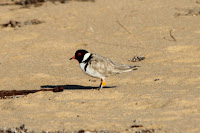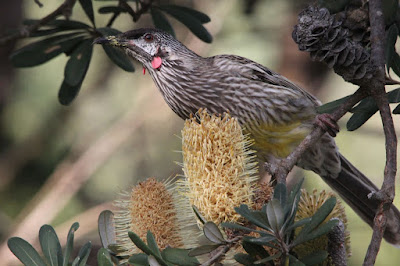In a recent post I was caught reflecting on birding and car parks!
A birder heading to a new destination opens their car door with much anticipation. Eyes scan the surrounds while ears soak in the sounds. What will reveal itself?
Sometimes a cacophony! The sounds are all around! Where to look? A buzz!
Sometimes, dead silence. Disappointment. Flatness.
I am thinking here of typical birding destinations where a country track delivers one into likely habitat. The "car park" may simply be a rarely visited clearing.
In response to mentioning the car park birding I recently enjoyed at
Mouth of Powlett River, I was reminded that:
"...car parks are a very good choice to shoot birds, but that means people have been feeding them of left food of some kind...
With birds it might not be such a problem though, but where wild animals such as baboons in Africa are concerned, they become very dangerous and have to put be eventually put down... a pity!" Noushka
Thanks Noushka! We all know of such places where birds have become populous as a result of feeding at the car parks of tourist destinations or picnic areas. Noushka is right about such places and as birders, we tend not to frequent them!
I guess that my "great car park birding" sites are really places where simply opening the car door plunges one into a memorable birding experience - no actual car park required! Of course there are many factors contributing including season, time of day and weather.
I now feel an urge to make some lists (I am a birder after all)!
Pete's memorable "car park birding" sites:
- Ti-tree car park, Mouth of Powlett River Reserve, Vic
- Ben Bennett Bushland Park, Caloundra, Qld
- Kamarooka Forest, near Bendigo, Vic
- Oswin Roberts Sanctuary, Phillip Island, Vic
- Yellingbo Conservation Reserve, Vic
Pete's forgettable "car park birding" sites (big build up, dead silence):
- Mortimer Nature Walk, Bunyip State Park, Vic (the birding picked up, there was just not a sound at first)
- Chiltern Box-Ironbark National Park, Vic (ditto)
- Loch Ard Gorge, Vic (went for Rufous Bristlebird and dipped)
Car parks with bird populations affected by human feeding:
- Gloucester Tree, WA (Western rosella, Western ringneck)
- Wilsons Promontory, Vic (Crimson rosella)
- Sherbrooke Forest, Vic (King parrot, Crimson rosella)
- Anywhere there is a chip and a seagull
And of course some pictures:
 |
| Supposedly wild Western Ringneck (Barnardius zonarius) at the Gloucester Tree, WA. March 2007. Some bloke driving an electric scooter was selling seed for $2 per back (he didn't look official! I wonder if it is still happening?) |
 |
| Yes, the misguided parents of these kids bought a bag! Western rosella (Platycerus icterotis). Gloucester Tree, WA. March 2007 |
 |
| Australian King-parrot (Alisterus scapularis). Sherbrooke Forest car park |
 |
| The picnic area at Sherbrooke Forest (on a quiet day!) |
And now some excellent photos of signs at some of my favourite birding spots!
















































